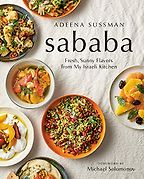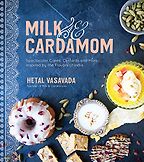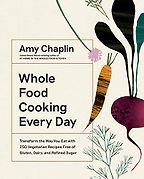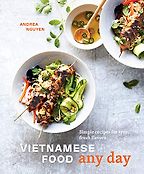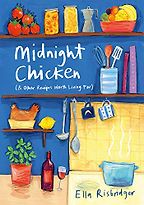Before we discuss your selection of the best cookbooks of 2019, I wanted to ask about how you got into cooking. Did you cook before you were a journalist, or did you become a journalist and then go into cooking?
It was a simultaneous process. I didn’t grow up cooking very much. My mom cooked well, but she was more of a baker. I’m very passionate about baking and I started dabbling in the kitchen when I was in college one summer, when I lived off-campus and I had an apartment for the first time. When I had my first job at a small newspaper where I didn’t have particularly demanding hours, I started cooking a lot more. Basically I’m a self-taught cook. I just made a lot of recipes. I read cookbooks.
I watched a lot of the instructional TV, a lot of Food Network‘s work, especially the early very instructional, less entertainment-focused programmes and a lot of America’s Test Kitchen. Then I just started cooking a lot at home and it became a hobby. I didn’t get into food journalism for a couple of years. It was my second gig here at the Washington Post and it has been a slow progression since then. Now I’m a full-time food writer.
What’s the key to improving your cooking abilities? Is it just to do a lot of it?
Don’t be afraid to fail. Keep trying to read as well as cooking a lot. I just read a lot of cookbooks. Even if I don’t end up cooking anything out of them, I think you can learn a lot that way. And talk to other people who cook.
Let’s turn to the cookbooks you’ve chosen as the best of 2019. First is Sababa: Fresh, Sunny Flavors from My Israeli Kitchen by Adeena Sussman. Why have you chosen this?
I actually got to meet Adeena when she came to the Post and we did an Instagram story with her, so I was familiar with the book and the food and one of my colleagues has picked it as her favourite cookbook of the year.
Israeli food and Middle Eastern food is really having a moment here in the US. It’s such a sunny, bright cuisine and, when I read the book, I can really feel Adeena’s zest for this cuisine. She’s this joyful, giving, warm person and that really comes over. As for the food, it’s a mix of stuff, some traditional and some of which is a little bit more of a mash-up.
“I read a lot of cookbooks. You can learn a lot that way”
She has a recipe for Israeli ‘everything spice’, which is a really fun idea. She starts adding in things you find in Israel and she also has some other really clever fusion dishes. She has a ‘pitaquiles’ dish which uses pita breads in place of the tortilla chips. Chilaquiles are kind of a traditional Mexican dish where you have a sauce and you have tortilla chips, but here you use pitas.
A few more things I liked about it: aesthetically, it’s really nice. You really feel like you’re in Israel. There’s a lot of bright colours. It feels like you could be standing in front of a window in Tel Aviv on a beautiful sunny day. She introduces you to a lot of ingredients that, even if you don’t end up making any of the dishes, maybe you just end up using elsewhere. For instance, she also introduces some clever swaps, like using date syrup instead of honey. And she has this tahini magic shell, which is brilliant. It’s just really fun stuff like that. And I’ve had a couple of the dishes out of the book and they’re delicious.
Moving on to Milk and Cardamom by Hetal Vasavada. She’s an Indian-American cook, right?
Yes. She’s a first generation American and it feels like a timely book, not just thinking about the food itself. Obviously, there’s a big immigration debate going on in America and she gives a sense of what it’s like straddling two worlds. I think that will really appeal to a lot of people.
There’s a little bit of a memoir, but it’s really about the food. I’m really passionate about baking and desserts, and I think Indian desserts are totally under-appreciated in the US. Americans aren’t really familiar with them. I love them. They tend to be a little bit on the sweet side, but I’m okay with that.
Get the weekly Five Books newsletter
I remember flipping through this book when it first came out and I wanted to make almost everything, which is always a good sign. She has this nice mix of traditional Indian desserts and then dishes that are more of a mash-up or ‘inspired by’. So the recipe I’m going to be featuring in our package is a gulab jamun Bundt cake. Gulab jamun are basically doughnuts that are first of all fried dough balls, which are then soaked in a syrup. They’re a pain to make and you have to fry them and so she gets those flavours and applies them to a bundt cake, which you soak in a syrup. So you’ve got that flavour and texture of gulab jamun but in a much easier-to-execute format.
And, like Adeena, she also had a little bit about introducing you to ingredients that you can incorporate into your cooking.
Next up on your list of the best cookbooks of 2019 is Amy Chaplin’s Whole Food Cooking Every Day. This is the vegetarian option, isn’t it?
Yes. Everything is made with whole foods. Everything is made from scratch. It’s vegetarian and it is also gluten-free. There are some recipes with eggs, but you also have a lot of vegan options for baked goods.
She gives a lot of master recipes that you can then craft yourself. There’s a master nut butter recipe and there are different ways to combine the nuts or to combine them with different herbs and spices. There’s a master non-dairy milk recipe and then you can start adding in your flavourings.
It’s also not preachy, which can be a pitfall for these kinds of books. She’s very relaxed. We’ve run one recipe from the book already, which was a pine nut sauce with pasta and it was one of our best performing recipes. The readers just loved it. It’s another recipe where she gives you different variations for the seasons. There’s no refined sugar in there, which is appealing to a lot of people these days. And she makes use of a lot of interesting grains and the flavours are really clear and simple but delicious.
We’re now at book four on your list of the best cookbooks of 2019: Vietnamese Cooking Any Day by Andrea Nguyen.
I love Andrea. She’s a great teacher and that really comes across in this book. Vietnamese food is not something that has made a lot of headway into home cooking in America. We go out to Vietnamese restaurants, but it’s not a cuisine that a lot of people make at home. And I think that alone makes this book worth paying attention to.
Like Hetal Vasavada, Andrea is a first generation American. Her family fled Vietnam and moved to California. She grew up without much access to the ingredients that her family had had in Vietnam and sometimes they would travel several hours to get what they needed, shopping at a lot of the local grocery stores.
A major premise of the book is that these are all ingredients that can be found at mainstream supermarkets today. Thankfully, mainstream supermarkets are now a lot better than when Andrea was young. So it’s easy to find fish sauce and sesame oil and even rice paper and rice noodles. There’s a lot of fried shallots in Vietnamese cuisine, but she uses French’s fried onions, which is a perfect stand-in.
Five Books interviews are expensive to produce. If you're enjoying this interview, please support us by donating a small amount.
She talks about trying to make recipes that are streamlined but not dumbed down and she redoes classic dishes with some non-traditional ingredients. So the recipes are things that you feel like you could probably accomplish on a weeknight.
She has advice on everything from how to boil rice, to how to roll rice paper, or bruise-versus-smash ingredients. For someone who’s lacking a bit of confidence in the kitchen, she can really teach you a lot.
Finally, Midnight Chicken by Ella Risbridger, which I think is perhaps more than a pure cookery book.
It really is different from any other cookbook that I’ve seen, even down to the look of it. It looks almost like a novel by its shape and the paper used.
It’s a combination of cookbook and memoir. You could read the whole book cover-to-cover and be satisfied, even if you didn’t make a dish from it. Obviously the writing is beautiful. She has just edited a poetry anthology, which makes total sense. Just flip through it and on every page there’s great writing. There’s this passage about making bread, where she talks about the sound of your knuckles rapping on the base of the baked bread, the morning sun in the window and the dust motes. I mean, you just want to read on.
But she’s very conversational and the recipes are not written in a complicated way. It’s very straightforward recipe writing. It’s done with these short sentences: do this, do that—it reminds me a bit of William Carlos Williams. It’s really refreshing in that way. There’s not a lot of flouncy language. It feels like she’s talking to you, but it’s not so casual that it’s cutesy.
It’s not exclusively devoted to cooking chicken, or is it?
No, no. The name comes from this particularly bad night she had. She describes how she was in despair just lying on the floor in her apartment and just looking at this chicken hanging in a bag on the chair.
She’s with her boyfriend and she got off the floor and they cook the chicken and eat it at night with bread and garlic. Even that’s just a beautiful passage. So it’s worth the read, even if you’re not going to cook. All the recipes are good. We ran one, a broccoli toast, which was simple and delicious—not at all intimidating.
The Washington Post’s 2019 cookbook roundup—featuring 11 books—can be found here.
Interview by Benedict King
December 15, 2019. Updated: February 1, 2023
Five Books aims to keep its book recommendations and interviews up to date. If you are the interviewee and would like to update your choice of books (or even just what you say about them) please email us at [email protected]
